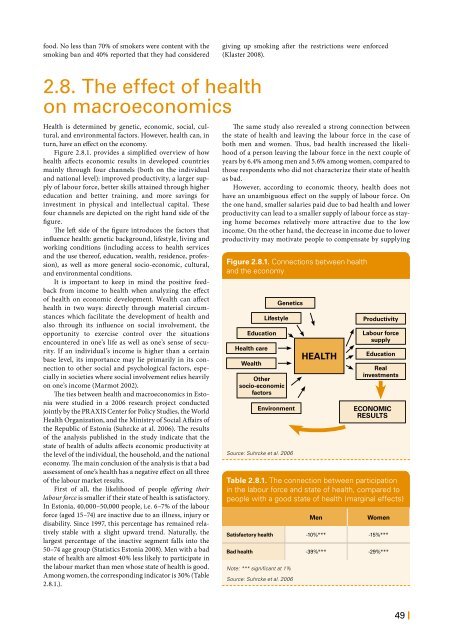Estonian Human Development Report
Estonian Human Development Report - Eesti Koostöö Kogu
Estonian Human Development Report - Eesti Koostöö Kogu
You also want an ePaper? Increase the reach of your titles
YUMPU automatically turns print PDFs into web optimized ePapers that Google loves.
food. No less than 70% of smokers were content with the<br />
smoking ban and 40% reported that they had considered<br />
giving up smoking after the restrictions were enforced<br />
(Klaster 2008).<br />
2.8. The effect of health<br />
on macroeconomics<br />
Health is determined by genetic, economic, social, cultural,<br />
and environmental factors. However, health can, in<br />
turn, have an effect on the economy.<br />
Figure 2.8.1. provides a simplified overview of how<br />
health affects economic results in developed countries<br />
mainly through four channels (both on the individual<br />
and national level): improved productivity, a larger supply<br />
of labour force, better skills attained through higher<br />
education and better training, and more savings for<br />
investment in physical and intellectual capital. These<br />
four channels are depicted on the right hand side of the<br />
figure.<br />
The left side of the figure introduces the factors that<br />
influence health: genetic background, lifestyle, living and<br />
working conditions (including access to health services<br />
and the use thereof, education, wealth, residence, profession),<br />
as well as more general socio-economic, cultural,<br />
and environmental conditions.<br />
It is important to keep in mind the positive feedback<br />
from income to health when analyzing the effect<br />
of health on economic development. Wealth can affect<br />
health in two ways: directly through material circumstances<br />
which facilitate the development of health and<br />
also through its influence on social involvement, the<br />
opportunity to exercise control over the situations<br />
encountered in one’s life as well as one’s sense of security.<br />
If an individual’s income is higher than a certain<br />
base level, its importance may lie primarily in its connection<br />
to other social and psychological factors, especially<br />
in societies where social involvement relies heavily<br />
on one’s income (Marmot 2002).<br />
The ties between health and macroeconomics in Estonia<br />
were studied in a 2006 research project conducted<br />
jointly by the PRAXIS Center for Policy Studies, the World<br />
Health Organization, and the Ministry of Social Affairs of<br />
the Republic of Estonia (Suhrcke at al. 2006). The results<br />
of the analysis published in the study indicate that the<br />
state of health of adults affects economic productivity at<br />
the level of the individual, the household, and the national<br />
economy. The main conclusion of the analysis is that a bad<br />
assessment of one’s health has a negative effect on all three<br />
of the labour market results.<br />
First of all, the likelihood of people offering their<br />
labour force is smaller if their state of health is satisfactory.<br />
In Estonia, 40,000–50,000 people, i.e. 6–7% of the labour<br />
force (aged 15–74) are inactive due to an illness, injury or<br />
disability. Since 1997, this percentage has remained relatively<br />
stable with a slight upward trend. Naturally, the<br />
largest percentage of the inactive segment falls into the<br />
50–74 age group (Statistics Estonia 2008). Men with a bad<br />
state of health are almost 40% less likely to participate in<br />
the labour market than men whose state of health is good.<br />
Among women, the corresponding indicator is 30% (Table<br />
2.8.1.).<br />
The same study also revealed a strong connection between<br />
the state of health and leaving the labour force in the case of<br />
both men and women. Thus, bad health increased the likelihood<br />
of a person leaving the labour force in the next couple of<br />
years by 6.4% among men and 5.6% among women, compared to<br />
those respondents who did not characterize their state of health<br />
as bad.<br />
However, according to economic theory, health does not<br />
have an unambiguous effect on the supply of labour force. On<br />
the one hand, smaller salaries paid due to bad health and lower<br />
productivity can lead to a smaller supply of labour force as staying<br />
home becomes relatively more attractive due to the low<br />
income. On the other hand, the decrease in income due to lower<br />
productivity may motivate people to compensate by supplying<br />
Figure 2.8.1. Connections between health<br />
and the economy<br />
Lifestyle<br />
Education<br />
Health care<br />
Wealth<br />
Other<br />
socio-economic<br />
factors<br />
Genetics<br />
Environment<br />
Source: Suhrcke et al. 2006<br />
HEALTH<br />
Productivity<br />
Labour force<br />
supply<br />
Education<br />
Real<br />
investments<br />
ECONOMIC<br />
RESULTS<br />
Table 2.8.1. The connection between participation<br />
in the labour force and state of health, compared to<br />
people with a good state of health (marginal effects)<br />
Note: *** significant at 1%<br />
Source: Suhrcke et al. 2006<br />
Men<br />
Women<br />
Satisfactory health -10%*** -15%***<br />
Bad health -39%*** -29%***<br />
49 |















